Lesson 5 Where? 全英说课稿
文档属性
| 名称 | Lesson 5 Where? 全英说课稿 |  | |
| 格式 | zip | ||
| 文件大小 | 118.5KB | ||
| 资源类型 | 教案 | ||
| 版本资源 | 冀教版(三年级起点) | ||
| 科目 | 英语 | ||
| 更新时间 | 2018-10-12 23:30:47 | ||
图片预览

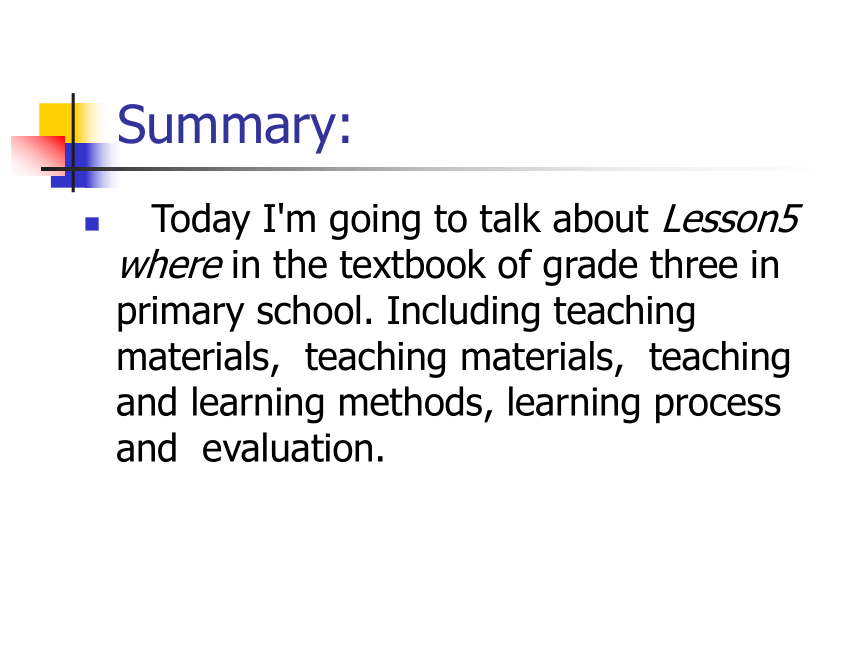
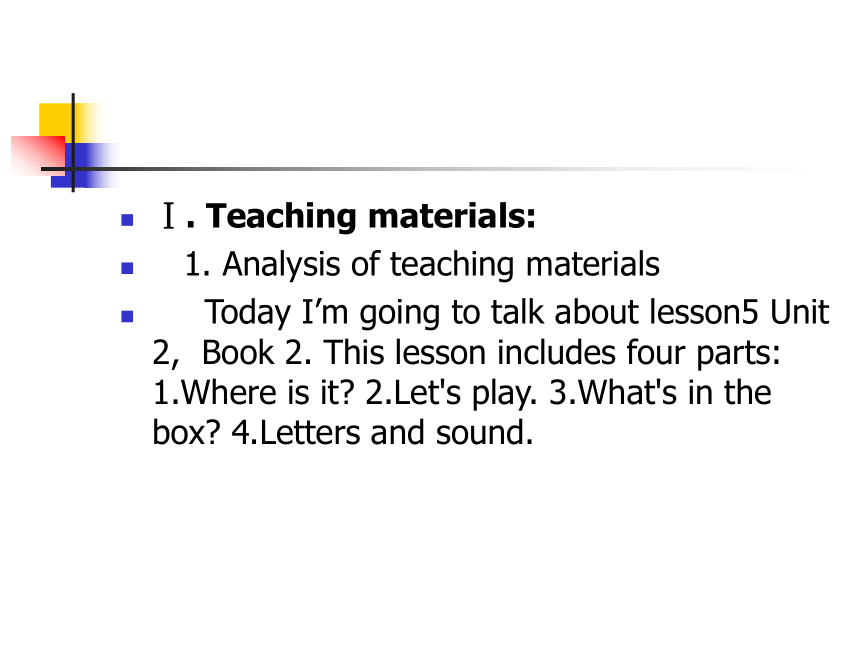
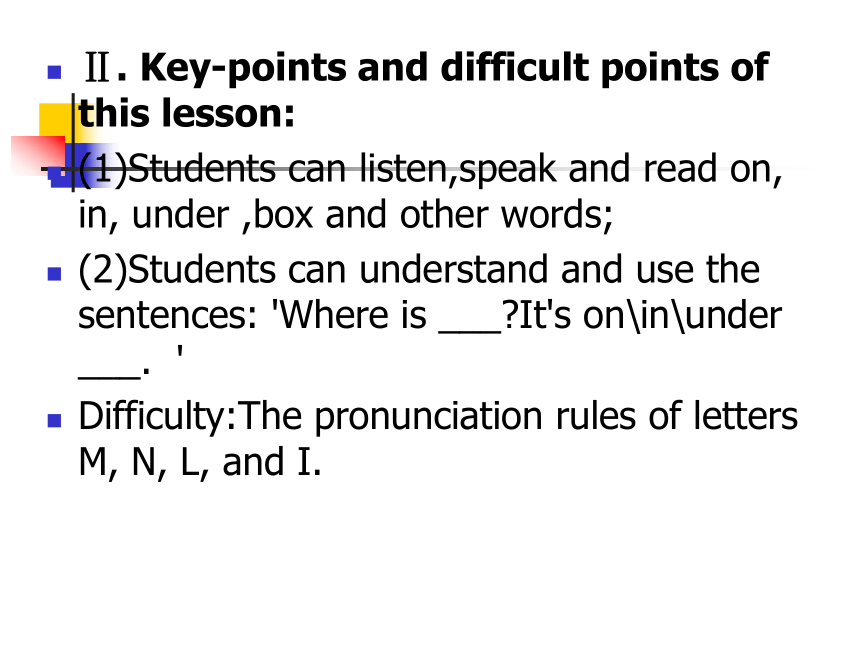
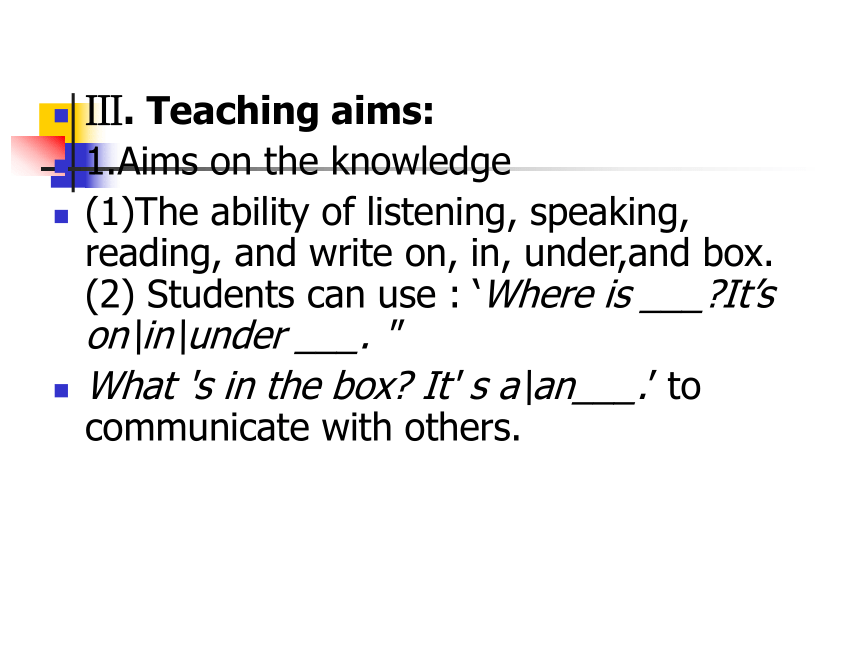
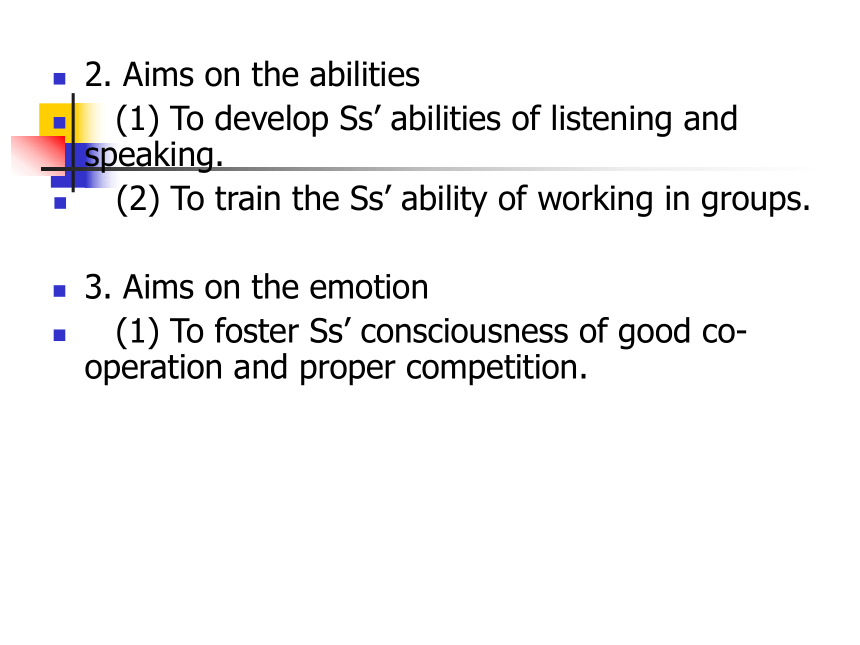
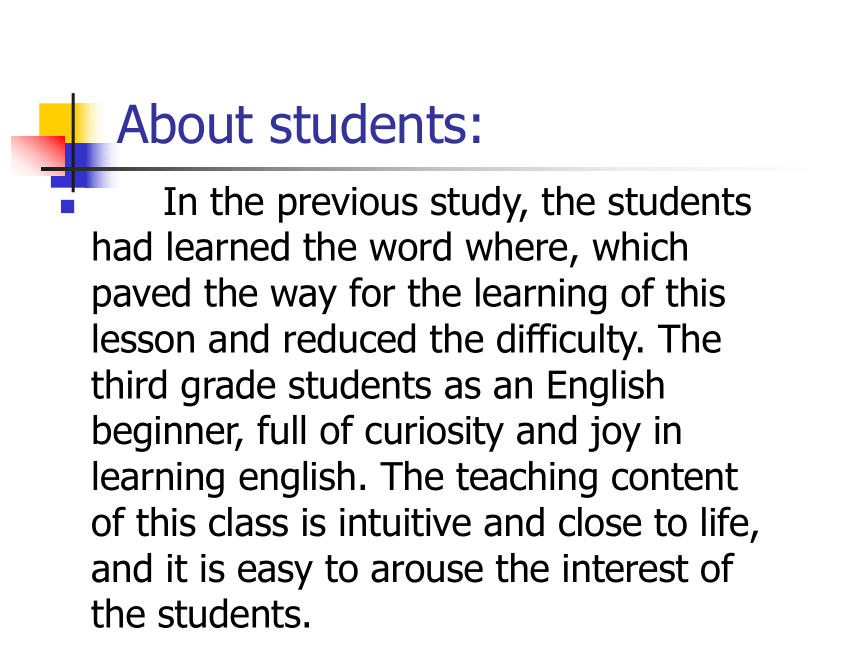
文档简介
小学冀教版(三年级起始) 教材三年级下册Lesson5说课稿
Summary:
Today I'm going to talk about Lesson5 where in the textbook of grade three in primary school. Including teaching materials, teaching materials, teaching and learning methods, learning process and evaluation.
Ⅰ. Teaching materials:
1. Analysis of teaching materials
Today I’m going to talk about lesson5 Unit 2, Book 2. This lesson includes four parts: 1.Where is it? 2.Let's play. 3.What's in the box? 4.Letters and sound.
Ⅱ. Key-points and difficult points of this lesson:
(1)Students can listen,speak and read on, in, under ,box and other words;
(2)Students can understand and use the sentences: 'Where is ___?It's on\in\under ___. '
Difficulty:The pronunciation rules of letters M, N, L, and I.
Ⅲ. Teaching aims:
1.Aims on the knowledge
(1)The ability of listening, speaking, reading, and write on, in, under,and box. (2) Students can use : ‘Where is ___?It’s on\in\under ___. "
What 's in the box? It' s a\an___.’ to communicate with others.
2. Aims on the abilities
(1) To develop Ss’ abilities of listening and speaking.
(2) To train the Ss’ ability of working in groups.
3. Aims on the emotion
(1) To foster Ss’ consciousness of good co-operation and proper competition.
About students:
In the previous study, the students had learned the word where, which paved the way for the learning of this lesson and reduced the difficulty. The third grade students as an English beginner, full of curiosity and joy in learning english. The teaching content of this class is intuitive and close to life, and it is easy to arouse the interest of the students.
Ⅴ. Teaching methods:
As we all know: the main instructional aims of learning English in primary school is to cultivate pupils’ basic abilities of listening and speaking and their good sense of the English language. So in this lesson, I’ll mainly use “Task-based” teaching method. That 's to say, I will let the Ss learn in real situations, finish a task by making a survey to help the Ss to get a better understanding of the key structure of the dialogue. I will arrange four kinds of activities: singing, guessing game, finishing a survey and having a competition. And in this lesson a recorder (computer aided instruction), school things and a printed form will be needed. Students should prepare some school things.
Ⅵ. Teaching procedures and purposes of my designing:
I’ll finish this lesson in six steps.
Step 1. Warming-up and review: 5’
(1)Free talk between T and Ss about things in the classroom.
(2)Sing a song together: Old Macdonald had a farm
(3)Do some total physical response, for example: show me your English book, show me your cards.
Purpose : It is very important to form a better English learning surrounding for the Ss by singing and doing some total physical response and at the same time it provides situations to review learned knowledge for the next step.
Step 2. Presentation:
Now I’ll mainly talk about this step.
1,Present the pattern: “My schoolbag is heavy .”“What’s in it?”
(1)In order to create a relaxed atmosphere and arouse the interest of the students, I showed a dancer cat. And show all kinds of directions to teach the new words in this class.
(2)Then writing words and sentences on the blackboard and demonstrate.Read words and sentences by showing the slide of the cat's position.
Purpose: To present the key structures one by one is much easier for the Ss to learn and grasp the meaning, proper competition can arouse the Ss’ s interest in English learning.
To activate the atmosphere with gifts ,then introduce?the students to learning”What 's in the box?”
Teach ‘on, in ,under ’again with gestures, and ask students to use picture to demonstrate in group. To attract students' attention with a hands-on approach .
Play the cassette. Let the Ss listen and imitate the dialogue. Pay attention to their pronunciation and intonation. (of course, all the words are not just read out. In English there is a phonogram pronunciation rules) Showing a simple phonetic symbol at the end of class.
Step 3. Prediction for reading
Purpose: I will provide a real situation for the Ss to understand the dialogue and the relationships between people better. Tell the Ss we should know how to describe the location of an object.
Step 4. practice:
Conversation practice:learn how to use “Where is it? What's in the box?”.
To check of the understanding of "Where is it? What's in the box?”by the box game.
Purpose: Conversation practice is used here to develop Ss’ ability of communication and also their ability of co-operation will be well trained.
Step 5. Achievement exhibition :
Students listen and read the text.
Purpose: to check the knowledge Ss have learned in the period.
Step 6. Homework:
(1)Listening and repeat the text at home.
Purpose: Revision is so important that Ss should speak English as much as they as in class or after class. It is necessary for the Ss to do some extensive exercises after class to consolidate the knowledge they learned.
Blackboard Design:
Lesson 5 Where?
Where is the cat?
on the box.
It’s in the box.
under the box.
Summary:
Today I'm going to talk about Lesson5 where in the textbook of grade three in primary school. Including teaching materials, teaching materials, teaching and learning methods, learning process and evaluation.
Ⅰ. Teaching materials:
1. Analysis of teaching materials
Today I’m going to talk about lesson5 Unit 2, Book 2. This lesson includes four parts: 1.Where is it? 2.Let's play. 3.What's in the box? 4.Letters and sound.
Ⅱ. Key-points and difficult points of this lesson:
(1)Students can listen,speak and read on, in, under ,box and other words;
(2)Students can understand and use the sentences: 'Where is ___?It's on\in\under ___. '
Difficulty:The pronunciation rules of letters M, N, L, and I.
Ⅲ. Teaching aims:
1.Aims on the knowledge
(1)The ability of listening, speaking, reading, and write on, in, under,and box. (2) Students can use : ‘Where is ___?It’s on\in\under ___. "
What 's in the box? It' s a\an___.’ to communicate with others.
2. Aims on the abilities
(1) To develop Ss’ abilities of listening and speaking.
(2) To train the Ss’ ability of working in groups.
3. Aims on the emotion
(1) To foster Ss’ consciousness of good co-operation and proper competition.
About students:
In the previous study, the students had learned the word where, which paved the way for the learning of this lesson and reduced the difficulty. The third grade students as an English beginner, full of curiosity and joy in learning english. The teaching content of this class is intuitive and close to life, and it is easy to arouse the interest of the students.
Ⅴ. Teaching methods:
As we all know: the main instructional aims of learning English in primary school is to cultivate pupils’ basic abilities of listening and speaking and their good sense of the English language. So in this lesson, I’ll mainly use “Task-based” teaching method. That 's to say, I will let the Ss learn in real situations, finish a task by making a survey to help the Ss to get a better understanding of the key structure of the dialogue. I will arrange four kinds of activities: singing, guessing game, finishing a survey and having a competition. And in this lesson a recorder (computer aided instruction), school things and a printed form will be needed. Students should prepare some school things.
Ⅵ. Teaching procedures and purposes of my designing:
I’ll finish this lesson in six steps.
Step 1. Warming-up and review: 5’
(1)Free talk between T and Ss about things in the classroom.
(2)Sing a song together: Old Macdonald had a farm
(3)Do some total physical response, for example: show me your English book, show me your cards.
Purpose : It is very important to form a better English learning surrounding for the Ss by singing and doing some total physical response and at the same time it provides situations to review learned knowledge for the next step.
Step 2. Presentation:
Now I’ll mainly talk about this step.
1,Present the pattern: “My schoolbag is heavy .”“What’s in it?”
(1)In order to create a relaxed atmosphere and arouse the interest of the students, I showed a dancer cat. And show all kinds of directions to teach the new words in this class.
(2)Then writing words and sentences on the blackboard and demonstrate.Read words and sentences by showing the slide of the cat's position.
Purpose: To present the key structures one by one is much easier for the Ss to learn and grasp the meaning, proper competition can arouse the Ss’ s interest in English learning.
To activate the atmosphere with gifts ,then introduce?the students to learning”What 's in the box?”
Teach ‘on, in ,under ’again with gestures, and ask students to use picture to demonstrate in group. To attract students' attention with a hands-on approach .
Play the cassette. Let the Ss listen and imitate the dialogue. Pay attention to their pronunciation and intonation. (of course, all the words are not just read out. In English there is a phonogram pronunciation rules) Showing a simple phonetic symbol at the end of class.
Step 3. Prediction for reading
Purpose: I will provide a real situation for the Ss to understand the dialogue and the relationships between people better. Tell the Ss we should know how to describe the location of an object.
Step 4. practice:
Conversation practice:learn how to use “Where is it? What's in the box?”.
To check of the understanding of "Where is it? What's in the box?”by the box game.
Purpose: Conversation practice is used here to develop Ss’ ability of communication and also their ability of co-operation will be well trained.
Step 5. Achievement exhibition :
Students listen and read the text.
Purpose: to check the knowledge Ss have learned in the period.
Step 6. Homework:
(1)Listening and repeat the text at home.
Purpose: Revision is so important that Ss should speak English as much as they as in class or after class. It is necessary for the Ss to do some extensive exercises after class to consolidate the knowledge they learned.
Blackboard Design:
Lesson 5 Where?
Where is the cat?
on the box.
It’s in the box.
under the box.
同课章节目录
- Unit 1 Animals on the farm
- Lesson 1 On the farm
- Lesson 2 Cats and Dogs
- Lesson 3 Fish and Birds
- Lesson 4 Horses and Rabbits
- Lesson 5 Where?
- Lesson 6 Can I Help you ?
- Unit 2 Animals at the Zoo
- Lesson 7 At the Zoo
- Lesson 8 Tigers and Bears
- Lesson 9 How Many?
- Lesson 10 Where Do They Live?
- Lesson 11 What Do They Eat?
- Lesson 12 The Clever Monkey
- Unit 3 Food and Meals
- Lesson 13 I'm Hungry!
- Lesson 14 Would You Like Some Soup?
- Lesson 15 What's Your Favourite Food?
- Lesson 16 Breakfast ,Lunch and Dinne
- Lesson 17 What's for Breakfast?
- Lesson 18 The Magic Stone
- Unit 4 Food and Restaurants
- Lesson 19 I Like Fruit!
- Lesson 20 Hamburgers and Hot Dogs.
- Lesson 21 In the Restaurant.
- Lesson 22 How Much Is It ?
- Lesson 23 How Much Are They?
- Lesson 24 Alittle Monkey.
